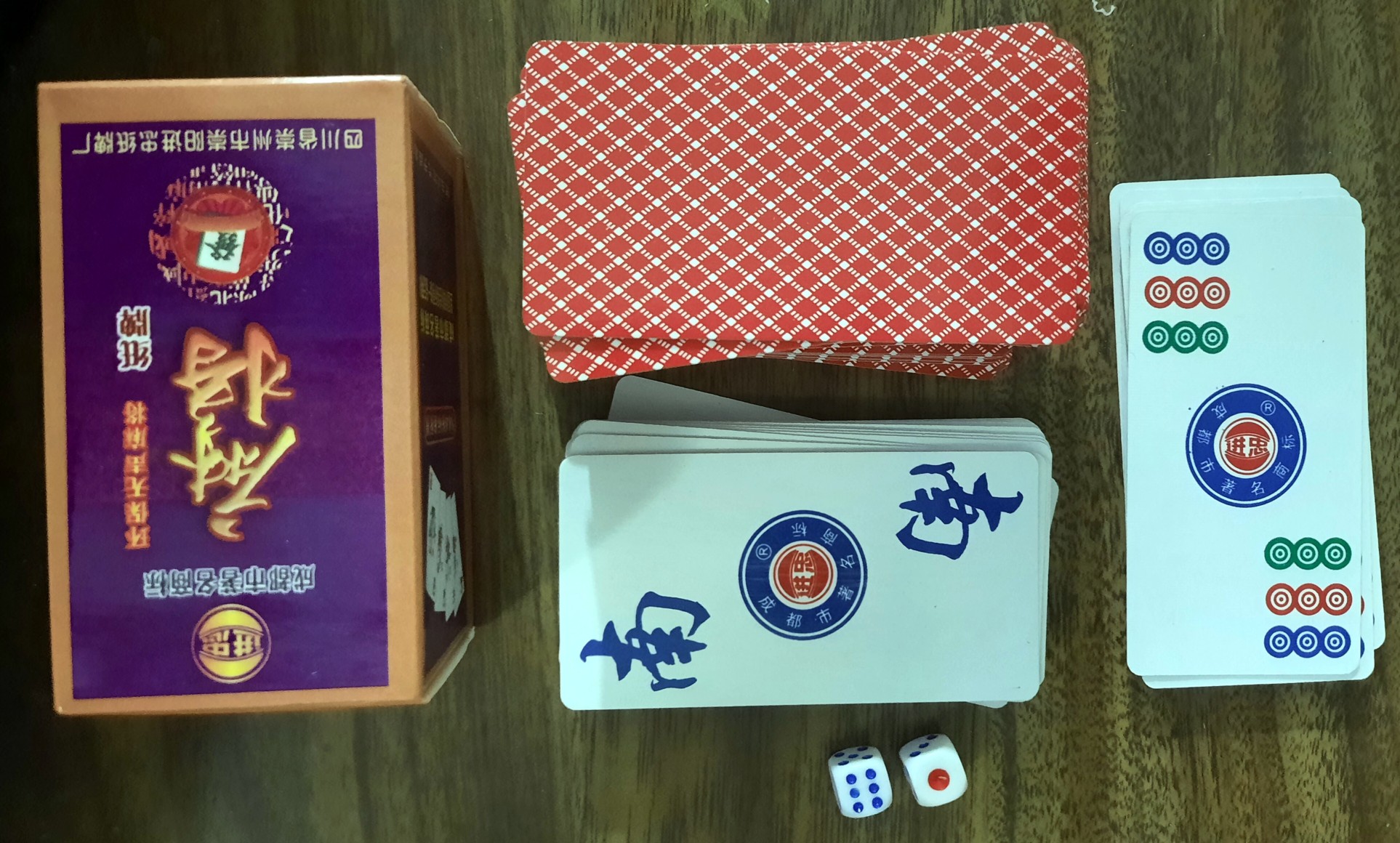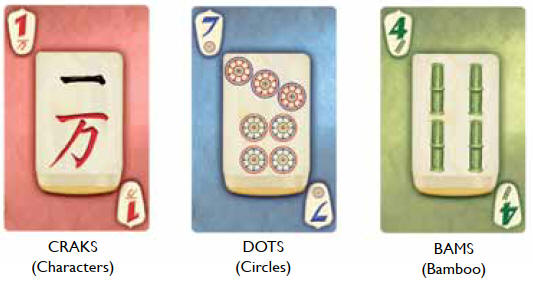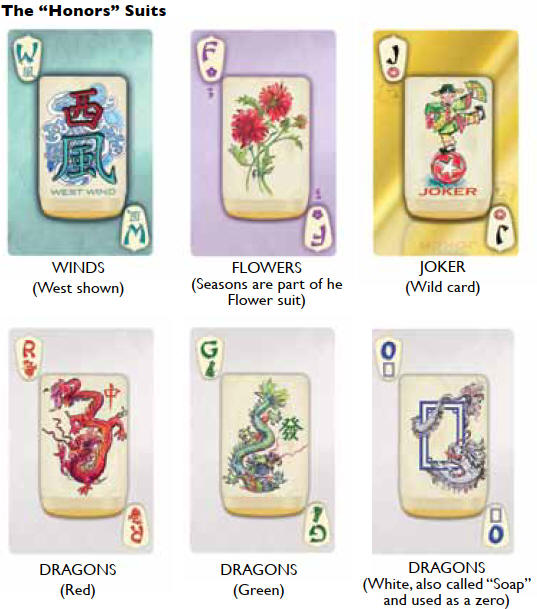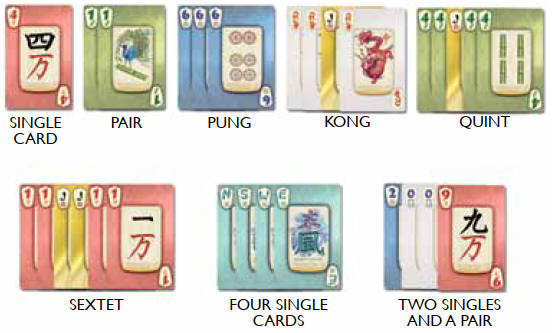
Mahjongg Cards rules
Jeux
Mah-Jongg

Mah Jongg American version
If you’re new to Mah Jongg, just read the seven points below to quickly begin playing. Details on each point are fully explained on the pages to follow.
1. GET READY TO PLAY
A dealer is appointed who shuffles and deals 13 cards to each player; 14 to
herself. Place the remaining deck face down in the tray’s draw compartment,
which is positioned in the middle of the table with the words “Dealer•EAST”
facing the dealer.
The OBJECT, in the beginner’s game, is to GO MAH JONGG by drawing and
discarding until you have 3 sets of FOUR identical cards, and one pair. Each
player starts with 650 points. A scorekeeper keeps track with a pencil and score
sheet.
2. THE CHARLESTON
Each player now exchanges three cards with the player sitting on the RIGHT,
then three cards with the player sitting OPPOSITE, then three cards with the
player on the LEFT.
3. PLAY
East (dealer) discards one card face up to start the game. Thereafter, play will pass to the RIGHT. On your turn, draw the top card, add it to your hand, and then discard a card face up on the discard pile. Play continues until someone goes mah jongg.
SETS are composed of multiple cards of the same-colored number (or letter) like the four Green Dragons or the 9-9-9-9 of the red suit (all suit have names as you’ll see). Jokers are wild. One or more can be used to represent the cards needed to complete a set.
4. CALLING
Whenever an opponent discards a card that you can use to complete a set of
four cards, you may call for it. If you do, you take it and LAY DOWN the
complete set to prove you’re correct. (This is the only time you lay down cards
prior to going mah jongg.)
5. WINNING THE HAND
Lay down your hand and shout out ”Mah Jongg” as soon as you have 3 sets of
four cards each, and a pair. (You do not discard on your final turn; you need
your final draw.)
6. SCORING
If you go mah jongg, you take points from each opponent (either 50 or 100
points from each–or more if you laid down no jokers. See scoring chart.)
7. PLAYING THE NEXT ROUND
EAST (dealer) is now the player on the right of the last dealer. She shuffles all cards and deals new hands. Play until each player is EAST once. High score wins.
• Once you’re experienced, you’ll want to use the expanded scoring on page above or, preferably, the National Mah Jongg League’s annual card.
Rules in Detail
1. GET READY TO PLAY
A dealer is appointed who shuffles the 152 cards and deals 13 cards to each player; 14 to herself. Place the remaining deck face down in the tray’s draw compartment, which is positioned in the middle of the table with the EAST side always facing the dealer.

The OBJECT, in the beginner’s game, is to GO MAH JONGG by drawing and discarding until you have 3 sets of FOUR identical cards, and one pair.
You win points by going mah jongg. Each player starts with 650 points.
A score keeper writes each player’s name at the top of a column. She updates scores after each round. Points are won by the player who goes mah jongg. Points are deducted from each opponent’s score (see “Scoring”).
A (beginner’s) Winning Hand – 3 sets of four cards and a pair.

THE CHARLESTON
Each player now tries to improve her hand by a series of exchanges known as “The Charleston” (named for the 1920’s dance craze).
Begin by exchanging three cards with the player sitting on your RIGHT. Add the ones received into your hand, then exchange three cards with the player sitting OPPOSITE you, then take three cards from hand and exchange with the player on your LEFT.
ADVANCED RULE (add this once you’re experienced)
Second Charleston: If one or more players wish to “Dance again,” a second Charleston is performed; repeat the process in the opposite order (pass first to the left, then across, then to the right).
Courtesy Pass: When the Charleston concludes, you may offer to exchange, sight unseen, one, two or three cards with the player seated opposite you. If this player agrees make the exchange.
Blind Pass: A player is permitted to Blind Pass one, two or three cards on the last pass of each Charleston.
For example, if a player only has two cards in hand that she wishes to part with, she may take one card passed to her, sight unseen, add it to these two cards and pass them along. She then adds to her hand the cards not involved in the blind pass.
Note: A Joker may never be passed during a Charleston or
Courtesy pass.
First pass to player on right.
Second pass to
player sitting opposite.
Third pass to player on left.
PLAY AND
THE Make UP Of THE Deck
East (dealer) begins by discarding one card face up to start the discard pile. Note how the discards go in sideways for ease of removal. This brings her hand back down to 13 cards. Play passes to the player on her RIGHT.
On your turn, draw the top card, add it to your hand, and
then discard a card face up on the discard pile. Play continues until someone
goes mah jongg. (Only the top card in this pileis “in play” as you’ll see under
“Calling.”)
The Deck
There are 152 cards in all. There are three main Suits, each comprised of 36 cards of the same color, four of each number 1 through 9.
For example: fourred 1’s (Craks), four blue 7’s (Dots) and four green 4’s (Bams).
There are also four Dragons of each color.
The sixteen Winds include four of each Wind (north, east, south, and west). There are eight Flowers (including the four Seasons, which count as Flowers in the American game). The eight Jokers are wild–and very important!
One, two or three Jokers can be used to represent the cards you need to complete a set of four. (Jokers may NOT be included in the pair you need to go mah jongg.)


CALLING AND CLAIMING JOKERS
Pay attention to the latest discard!
Whenever an opponent discards a card that you can use to complete a set of four cards, you may call for it. If you do, you take it and LAY DOWN the complete set to prove you’re correct. (This is the only time you lay down cards prior to laying down your remaining hand when going mah jongg.)
You may not call for a card to make a pair, unless you are going mah jongg as a result.
If two or more players call for the same card, the player calling for the card to go mah jongg has priority over any other player.
If not, then the one whose turn would come next receives the card.
You may not call for a card to add to a prior meld.
DISCARDING AFTER A CALL.
After calling, a player discards to bring her total
holdings to 13 cards. Play passes to the player on her right (meaning a player
or two might miss a turn!)
Claiming a joker
When it is your turn, after you complete your draw, you are then permitted to exchange one card from your hand, after you draw, for a melded Joker if it is the card the Joker represents.
You can even call for the exchange after another player calls for and lays down a meld, which includes a Joker. For example, West calls for the 8 of Dots and lays down two more 8 of Dots cards and a Joker.
You have an 8 of Dots in hand.
You can immediately exchange it for the Joker.
If you later draw a card that can be exchanged for a Joker, you may do so upon the draw, and then continue with your turn.
On rare occasions, you might find that you have too many Jokers in hand. This would happen if you need to complete a pair and are unable to use the Jokers. In this event, you may discard a Joker, but no one can call it.
WINNING THE HAND
You win the hand the moment you lay down your hand and shout “Mah Jongg.” (You do not discard on your final turn; your final draw is part of the fourteen cards you need.)
In the Beginner’s game, you go mah jongg as soon as you have three sets of 4 cards and a pair.
For advanced players, you go mah jongg when you complete the requirements for a winning hand, as listed below, or when using hands on the NMJL’s current card.
SCORING AND PENALTIES
If you go mah jongg, you take points from each opponent; these get added to your score.
If you are playing according to the beginner’s requirement, each opponent pays the winner 50 points. Thus, the winner’s score rises by +50 for each opponent. Fifty points is subtracted from each opponent’s current score.
It is possible to win or lose more points. If you draw your “mah jongg” card (rather than call for it from the discard pile), you are paid double.
That means each opponent loses 100 points while you gain 100 from each. Further, if there are no jokers among your melds, you are paid double. So, if you drew the card you needed to go mah jongg and your hand is jokerless, you will get 200 points from each opponent and each opponent will loses 200 points!
Penalties
Mistakes are costly in Mah Jongg. Your hand “goes dead” and you are out of the round if you ever misplay and end up with more or less than 13 cards in hand and on the table, or you declare mah jongg in error.
PLAYING THE NEXT ROUND
EAST (dealer) passes to the player on the right of the last dealer (formerly South). She shuffles all cards and deals new hands. Play until each player is EAST once. High score wins the game!
Once you’re experienced, you’ll want to use expanded
scoring, or the NMJL’s card.
WINNING HANDS – Advanced Rules
Once you are comfortable with the play of Mah Jongg, you should move beyond the beginner’s way to win. Refer to this chart. You can go mah jongg whenever your cards meet the requirement for one of these ten types of winning hands.
For your information, a “kong” is Chinese for “four of a kind,” while “pung” is Chinese for “three of a kind.”
Quints are five of kind, therefore at least one Joker must be included (unless composed of all Flowers).
| VALUE CARDS | NEEDED |
| 25 | Like Numbers: 3 kongs of any type and one pair |
| 30 | Like Numbers: 3 kongs–including one Dragon kong–and one pair |
| 25 | Even Numbers: 4 even pungs in 2 different suits and one pair |
| 30 | Run: two pairs, two pungs, one
kong – all of the same suit and con- sisting of four consecutive numbers like 2,2; 3,3,3; 4,4; 5,5,5,5; 6,6,6 |
| 30 | Even Numbers: three
even-numbered kongs in the same suit and a pair of Flowers or Dragons |
| 30 | Odd Numbers: three odd-numbered
kongs and one pair, all in the same suit |
| 35 | Winds/Dragons: one kong, two
pungs, two pairs–all of Winds and Dragons |
| 35 | “2011”: a pair of “1’s,” one
White Dragon, one “2,” plus a pair of Flowers and two kongs |
| 40 | Quints: two quints and two pairs
of consecutive numbers, all in two suits |
| 50 | Pairs: seven pairs including one
Flower pair, the others must all be even or odd numbered pairs |
Here are all the types of card combinations in American Mah Jongg.

USING THE NATIONAL MAH JONGG LEAGUE’S CARD
Once you’re an experienced player, we recommend you obtain the National Mah Jongg League’s annual card and use the winning hands printed on it.
The official Mah Jongg Card is organized in categories.
They are:
YEAR hands or other special numerical hands. These hands utilize single cards, and perhaps pairs, to represent the current year. For example, 1’s and 9’s for 1999, 2’s and 0’s for 2000. The white dragon represents a zero (its symbol looks like a “0”).
2468: Self-explanatory. These hands focus on even numbered hands.
MULTIPLICATION: These hands include numerical sets that determine the pair required. For example: FFFF 4444 4444 1 6. Here, you need four Flowers, four 4’s of one suit and four 4’s of a second suit. Since 4 x 4 = 16, the “pair” is a 1 and a 6 of a different suit.
QUINTS (five of a kind): Requires the use of Jokers, since there are only four cards of each number in a suit. However, a natural quint of five Flowers is possible.
SEXTETS (six of a kind): Requires at least 2 Jokers. A natural sextet of Flowers is possible.
CONSECUTIVE RUNS: These hands require groups of numbered cards in consecutive order, sometimes interspersed with Flowers or Dragons.
13579: These hands focus on odd numbers.
WINDS/DRAGONS: Hands made up primarily of Wind and Dragon cards, sometimes including numbers or Flowers. Winds and Dragons are often referred to as “honor” cards.
369’s: Self-explanatory.
SINGLES & PAIRS: Hands composed entirely of singles and pairs are a challenge to attain; you are not allowed to use Jokers. The singles and pairs hands contain a sample of all the hands above; i.e., one wind hand, a consecutive run hand, a 2468 hand, etc.
READING THE NMJL CARD
NMJL Mah Jongg cards are printed in three colors; red, blue and green. Please do not confuse these colors with the color of the main suits and dragons. If a hand is printed entirely in one color, it means that all cards in that hand must be from ONE SUIT.
Similarly, if a hand is printed in two colors, the cards are to be selected from TWO DIFFERENT SUITS, and if three colors, THREE DIFFERENT SUITS.
For example, in consecutive runs, a hand may read: 11 222 3333 444 55, in all one color. In order to go mah jongg, you must have all the above cards, in the above order in one suit only.
For example, you are going for Dots, you must have 2 one Dots, 3 two Dots, 4 three Dots, etc.
Another hand may read: 444 555 6666 777, written in two colors with a parenthetical following it, (Any 2 suits, 4 consecutive numbers) This means that you must use two suits, but you may use any four consecutive numbers; you are not bound to play four through seven. You may go for 666 777 8888 9999, wherein the sixes and sevens must be one suit and the eights and nines must be another suit.
When the instructions refer to matching dragons, they are as follows:
Craks match with RED DRAGONS; Bams match with GREEN DRAGONS and Dots match with WHITE DRAGONS. White dragons are also known as “Soap” and also represents a zero.
Be careful, as some hands require matching dragons and others require opposite dragons. When a hand calls for opposite dragons, if you are using Dots, the Dragons must be either green or red; for Bams, white or red, etc. Flowers do not belong to any suit and are used wherever an F appears. The most challenging aspect of modern American Mah Jongg is to decide which kind of hand to aim for.
Choose wisely!
CHINESE MAH JONGG rules
Chinese Mah Jongg represents the original way to play the game. The American version is a modification of the classic Chinese game.
Once you know how to play American game, you only need to know which rules differ when playing Chinese Mah Jongg.
Why would you want to play the Chinese game?
Three reasons:
1. Unlimited potential to build winning hands.
2. Amazing scoring
possibilities
3. You can make runs (“chows”) – 3 or 4 sequential cards in a
suit, like 4, 5, 6, 7.
HOW TO WIN
The goal of this version is to go mah jongg before anyone else. To do so, you may assemble any combination of groups (pungs and kongs and one pair, totaling 14 cards).
GET READY TO PLAY
Remove the Joker and Flower cards; they aren’t used in the basic Chines game.
Flowers are added in the Advanced Game. Setup is otherwise identical to
American Mah Jongg. It is vital to turn the tray to face the East (the dealer),
as East Wind has higher scoring potential/risk than the other players.
THERE IS NO CHARLESTON IN CHINESE MAH JONGG.
PLAY
Once all players have sorted the cards dealt them, play begins with East
drawing and discarding. Play passes to the right, as usual.
CALLING
State the type of set you are completing when calling for a discard. Shout “pung” if you are laying down a set of 3 cards, or “kong” if laying down a set of four.
You can lay down “chows” 3 or 4 numerically sequential cards, like the 6, 7, 8 or the 3, 4, 5, 6 of Bams. You can claim a discard to complete whatever set you need to Go mah jongg, including your pair (you may not otherwise claim a card to form a pair.) Play passes to your right after you successfully call for a discard.
WINNING THE HAND
As soon as any player completes a hand, she calls out “Mah Jongg,” lays down all of the cards remaining in hand, verifies her cards, and claims victory. (In the remote event no one wins when the deck is exhausted, no one scores and the hand is void.)
SCORING
Scoring is much more elaborate in Chinese Mah Jongg than in the American version. First, score for the value of sets formed, then add any bonuses earned.
All players may score something, but must pay each other, as will be shown. The player who goes mah jongg pays nothing. East, as you’ll note below, doubles the points she must pay to any player, and also collects double if other players owe her.
A player always pays those who have earned a greater score.
For example, let’s say South went mahjongg and scored 24 points, West scored
6, North 36, and East 16.
Here’s what each player pays. First the winner,
South, collects:
• West pays South what South earned: 24 points.
• North also pays South
24 points.
• East pays South double, so 48 points.
Then players pay each other, as follows:
• West pays North 30 points (36 - 6)
• East pays North 40 (36 – 16
doubled)
• West pays East 20 (16 - 6 doubled)
Doubling is a powerful element of Chinese mah jongg. If you’ve earned several doubles, all of them count. For example, if you have 3 Red Dragons, 4 of your own Wind, and all other cards are of the same suit, you’ve earned three doubles.
These sets combined have earner you 40 points. But now you double once for your own Wind (80 points), then again for the Dragons (160 points), and once again for having all of the same suit—for a whopping 320 points!
| SETS FORMED | POINTS FOR EACH |
| Pung of
2’s through 8’s Pung of 1’s or 9’s Pung of a Wind or Dragon 4 Kong of 2’s through 8’s Kong of 1’s or 9’s Kong of Winds or Dragons Pair of Dragons or own Wind Chows |
2 4 8 16 16 2 0 4 |
| BONUS POSSIBILITIES | POINTS ADDED |
| If you go mah
jongg All your Sets are concealed in hand No Chows formed Draw the last card needed to go mah jongg Have a pung or kong of Dragons Have a pung or kong your own Wind All cards melded are of one suit All cards melded are Winds and Dragons only EAST WIND REMINDER |
20 Double basic pts 10 2 Double basic pts Double basic pts Double three times Double three times East Wind Always earns/ pays double |
It is suggested to include Limits in friendly games, players agree to a hand limit before play begins. For example, you can agree not to pay or collect more than 50 points between two players even if the actual points won or lost is higher.
PLAYING THE NEXT ROUND
Same as in the American game. EAST (dealer) is now the player on the right of the last dealer. She shuffles all cards and deals new hands. Play until each player is EAST once. High score wins.
ADDING THE FLOWER (“Hua”) Cards Advanced Rule
You may choose to include the eight Flower/Season cards. Whenever you draw one, or are dealt one, you immediately lay it down on the table and draw a replacement card.
If you go mah jongg, each Flower card laid down scores 1 extra point, before bonuses are determined. However, if you have all 4 Flowers, or all four Season cards, you also earn THREE doubles!
Note: Jokers are never used in Chinese Mah Jongg.
MAH JONGG ETTIQUETTE and PENALTIES
Many mistakes are possible and they incur penalties. Go online to winning-moves.com to resolve potential disputes. The most common ones are listed and regulated here. You’ll also find a brief, but fascinating history of Maj Jongg on the Winning Moves site.
RULES FOR THREE PLAYERS
There is no West Wind player in this game. Play is otherwise the same.
RULES FOR FIVE PLAYERS
Seat the fifth player between East and North. This player is named “North-East Wind.” Introduce four Flower cards into the deck. These are known as “North East Wind” and count as wind cards, especially for the North East Wind player.
RULES FOR SIX PLAYERS
Add another seat, this one between South and West. This player is the “South-West Wind.” Add all 8 Flowers into the deck. They are known as “Extra Wind” cards. Any three or four can be formed into a set of extra Winds.
If North-East and/or South-West collect a set of these, they score double for having done so.
Deal only 10 cards per hand to each player (11 to East). To win, 11 cards total need to be formed into sets, namely three pungs and one pair. Kongs cannot be formed.
